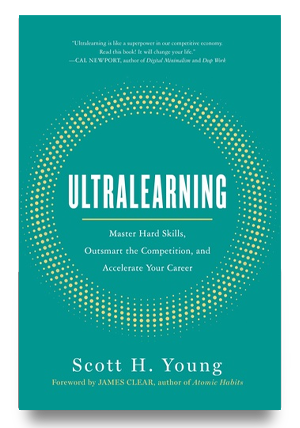Reading is one of the best methods to gather new ideas. I usually read at least a book per week, and I’ve been known to read as much as a book per day. I generally consider a book to have been a successful read if I can get a couple interesting ideas from it. Great books will have dozens of new viewpoints and ideas that can change the way you think about your world.
Thriving in the world requires you to have a specific strategy towards your reading. I’ve found three particular methods allow me to optimize the information I get out of books, the “T” model, idea hierarchies and certainty building or certainty reducing ideas. Reading effectively is more than just reading fast, it is reading smart.
The T Model
Recently I’ve begun applying the “T” model to the ideas I gather through the books I’m reading. For those of you who missed my post on specializing versus generalizing, the “T” model basically says that you should have a smaller vertical area of expertise and a broad horizontal area with just a minor amount of knowledge. Pick which areas you want to develop a lot of focus in and develop a brief understanding of the rest.
Following this model I’ve begun expanding the types of ideas I look for in the books I’m reading. The surprising thing is that even when the subject is completely different than your area of focus, it can often give you completely new perspectives for looking at your old problems. This is really the power of broadening your reading base is that it can allow you to look at problems from a vantage point you may not have considered before.
I recently finished Niccolo Machiavelli’s, The Prince, his famous work on the art of war and statecraft. Considering history has made quite the infamy out of Machiavelli’s thinking I was surprised how his ideas were presented with logic and precision. Even if I disagree with Machiavelli on some of his methods, the insights offered were powerful. I found myself relating his ideas to business, seeing connections between foreign aide and venture capital. This ability to piece together completely new perspectives from a peripheral source is one of the best reasons to broaden your reading base.
I would say that all reading, and possibly all art, works on a scale between how dense the ideas are and how abstract they are. Generally the most idea dense works are usually fairly practical, otherwise you would miss a lot of the ideas. But really abstract ideas are also helpful as they can provide you insights you wouldn’t have received if it were communicated directly.
Reading works like Shakespear give you a fantastic picture of human nature and emotions that often lose their power when you translate the ideas directly. It is the process of digging out the ideas from these works that you create the insights yourself. Although it may be a more lengthy process than reading a self-help book, the insights you get from these sources are more rare.
Idea Hierarchies
Another way of grouping ideas is on a hierarchy. At the top of the hierarchy you have your global ideas that are esoteric and apply to everything. These are existential questions like the meaning of life, religion or the nature of reality. On the very bottom of the hierarchy you have practical ideas like how to maintain a website or build a birdhouse. Ideas tend to form somewhere between the details and the bigger picture.
I like to combine practical ideas with broad general ones when reading. So if I have just finished a book on web programming, I might read a book on Buddhism next. Oscillating between the most practical ideas and the most esoteric ones allows you to have a more unified worldview. You can move up and down the hierarchy as you need to.
You need to gather both types of ideas to function effectively. If you focus exclusively on the details, you may be really effective at certain things but you will lack the larger scope. If you focus entirely on big ideas you may lose sight of the things you need to do today. Having a balance between these types of ideas helps you both function and understand.
Certainty Reduction or Bolstering Ideas
Another way you can group ideas is whether they bolster or reduce your internal level of certainty. Having too little certainty in the outside world creates doubt, fear and can keep you from moving forward. Without certainty that the floor is going to support you, it isn’t going to be easy to walk over it.
Too much certainty can also be disastrous. When you are too certain of an idea, you are blinded by it’s potential flaws. Too much certainty makes your ideas rigid and incapable of growth. Often certainty builds up until it is so hard and brittle that a swift stroke of reality shatters it all at once. Although it feels nice to be certain of something, too much can lead to a painful blow later.
Idea gathering should walk the fine line between certainty reduction and bolstering. This line isn’t 50/50 either. It depends on your individual situation. If you are worried about not going forward with a goal or taking action, your need to start by bolstering your certainty. When I became a vegetarian, I sought out certainty enabling references so that I would stick with my commitment.
When your action is pretty much guaranteed, that is the time you need to reduce your certainty so you can observe possible flaws. After being a vegetarian for over a year, I am now willing to learn about ideas that may contradict my own so I can find flaws and make improvements.
Most people do the complete opposite approach when trying to manage certainty. When they aren’t likely to take action these people find a bunch of contradicting references that keep them from taking action. When they are already successful they reinforce their certainty and often ignore glaring flaws. You need to turn this process on it’s head to balance action and effectiveness.
Reading is a powerful method to gather ideas. Effectively gather ideas doesn’t just mean reading faster, but reading smarter. Using the T model, idea hierarchies and levels of certainty can help you decide what to read to optimize your approach.


 I'm a Wall Street Journal bestselling author, podcast host, computer programmer and an avid reader. Since 2006, I've published weekly essays on this website to help people like you learn and think better. My work has been featured in The New York Times, BBC, TEDx, Pocket, Business Insider and more. I don't promise I have all the answers, just a place to start.
I'm a Wall Street Journal bestselling author, podcast host, computer programmer and an avid reader. Since 2006, I've published weekly essays on this website to help people like you learn and think better. My work has been featured in The New York Times, BBC, TEDx, Pocket, Business Insider and more. I don't promise I have all the answers, just a place to start.